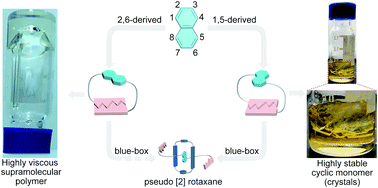Supramolecular polymerization and cyclization of dioxynaphthalene motif bridged bifunctional UPys: minor variations in the molecular skeleton and drastic differences in self-assembly†
Abstract
The relationship between molecular structure and macroscopic characteristics is a fundamental issue for materials design. Some minor changes in molecular structure may have a great impact on the molecular self-assembly process. Therefore, it is of interest to design new isomeric building blocks for supramolecular self-assembly, offering inspiration for the development of smart materials by supramolecular engineering. In this study, two dioxynaphthalene (DNP) group bridged bifunctional ureidopyrimidinone (UPy) monomers (DNP1 and DNP2) were synthesized. The chemical structures of the two isomers are very similar and the only difference is that DNP1 is 2,6-substituted and DNP2 is 1,5-substituted on the DNP motif. Interestingly, these two isomers exhibit completely different supramolecular self-assembly behaviors. Highly viscous supramolecular polymers were obtained in a concentrated solution of DNP1, while crystals based on highly stable cyclic monomers were precipitated from a concentrated solution of DNP2. Since DNP is an electron rich group, the host–guest behaviors of DNP1 and DNP2 with a blue-box were further studied, which also showed different ring-threading capabilities.

- This article is part of the themed collection: Mechanical Bond and Dynamic Covalent Bond


 Please wait while we load your content...
Please wait while we load your content...